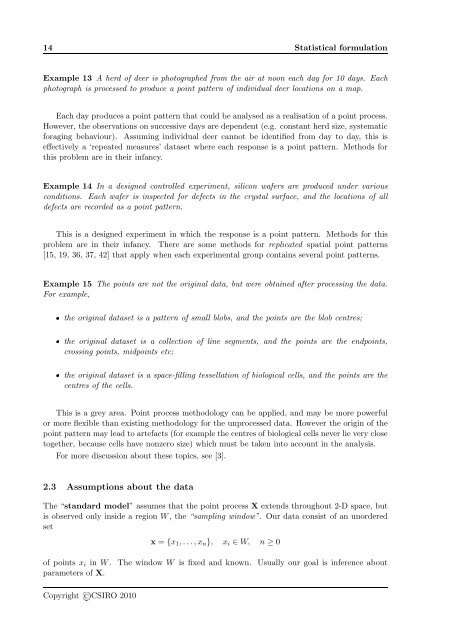Analysing spatial point patterns in R - CSIRO
Analysing spatial point patterns in R - CSIRO
Analysing spatial point patterns in R - CSIRO
Create successful ePaper yourself
Turn your PDF publications into a flip-book with our unique Google optimized e-Paper software.
14 Statistical formulation<br />
Example 13 A herd of deer is photographed from the air at noon each day for 10 days. Each<br />
photograph is processed to produce a <strong>po<strong>in</strong>t</strong> pattern of <strong>in</strong>dividual deer locations on a map.<br />
Each day produces a <strong>po<strong>in</strong>t</strong> pattern that could be analysed as a realisation of a <strong>po<strong>in</strong>t</strong> process.<br />
However, the observations on successive days are dependent (e.g. constant herd size, systematic<br />
forag<strong>in</strong>g behaviour). Assum<strong>in</strong>g <strong>in</strong>dividual deer cannot be identified from day to day, this is<br />
effectively a ‘repeated measures’ dataset where each response is a <strong>po<strong>in</strong>t</strong> pattern. Methods for<br />
this problem are <strong>in</strong> their <strong>in</strong>fancy.<br />
Example 14 In a designed controlled experiment, silicon wafers are produced under various<br />
conditions. Each wafer is <strong>in</strong>spected for defects <strong>in</strong> the crystal surface, and the locations of all<br />
defects are recorded as a <strong>po<strong>in</strong>t</strong> pattern.<br />
This is a designed experiment <strong>in</strong> which the response is a <strong>po<strong>in</strong>t</strong> pattern. Methods for this<br />
problem are <strong>in</strong> their <strong>in</strong>fancy. There are some methods for replicated <strong>spatial</strong> <strong>po<strong>in</strong>t</strong> <strong>patterns</strong><br />
[15, 19, 36, 37, 42] that apply when each experimental group conta<strong>in</strong>s several <strong>po<strong>in</strong>t</strong> <strong>patterns</strong>.<br />
Example 15 The <strong>po<strong>in</strong>t</strong>s are not the orig<strong>in</strong>al data, but were obta<strong>in</strong>ed after process<strong>in</strong>g the data.<br />
For example,<br />
the orig<strong>in</strong>al dataset is a pattern of small blobs, and the <strong>po<strong>in</strong>t</strong>s are the blob centres;<br />
the orig<strong>in</strong>al dataset is a collection of l<strong>in</strong>e segments, and the <strong>po<strong>in</strong>t</strong>s are the end<strong>po<strong>in</strong>t</strong>s,<br />
cross<strong>in</strong>g <strong>po<strong>in</strong>t</strong>s, mid<strong>po<strong>in</strong>t</strong>s etc;<br />
the orig<strong>in</strong>al dataset is a space-fill<strong>in</strong>g tessellation of biological cells, and the <strong>po<strong>in</strong>t</strong>s are the<br />
centres of the cells.<br />
This is a grey area. Po<strong>in</strong>t process methodology can be applied, and may be more powerful<br />
or more flexible than exist<strong>in</strong>g methodology for the unprocessed data. However the orig<strong>in</strong> of the<br />
<strong>po<strong>in</strong>t</strong> pattern may lead to artefacts (for example the centres of biological cells never lie very close<br />
together, because cells have nonzero size) which must be taken <strong>in</strong>to account <strong>in</strong> the analysis.<br />
For more discussion about these topics, see [3].<br />
2.3 Assumptions about the data<br />
The “standard model” assumes that the <strong>po<strong>in</strong>t</strong> process X extends throughout 2-D space, but<br />
is observed only <strong>in</strong>side a region W, the “sampl<strong>in</strong>g w<strong>in</strong>dow”. Our data consist of an unordered<br />
set<br />
x = {x 1 ,... ,x n }, x i ∈ W, n ≥ 0<br />
of <strong>po<strong>in</strong>t</strong>s x i <strong>in</strong> W. The w<strong>in</strong>dow W is fixed and known. Usually our goal is <strong>in</strong>ference about<br />
parameters of X.<br />
Copyright<strong>CSIRO</strong> 2010












